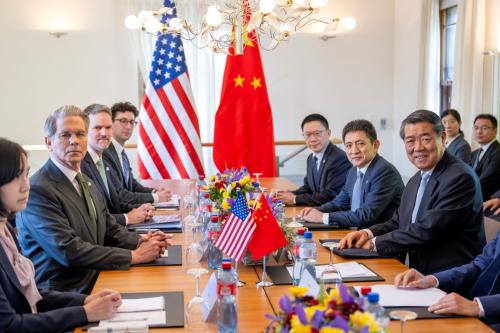In her first visit to Washington this week in her new role, European Union Commissioner for Trade Cecilia Malmström came to the Brookings Institution for a luncheon discussion of her trade priorities and next steps on the Transatlantic Trade and Investment Partnership (TTIP).
Throughout her meetings with U.S. government officials, members of Congress and others, the commissioner made clear her commitment to reinvigorate the negotiations.
This is welcome news, particularly with the new commission just in place, a new congressional session about to begin and no shortage of challenges ahead on both sides of the Atlantic. The time is ripe to formulate a plan for a fresh start to make as much progress as possible on TTIP in the new year. The task of reaching a transatlantic agreement will only get harder as the U.S. 2016 presidential election heats up.
The next period of negotiations will not be easy, and both Commissioner Malmström and U.S. Trade Representative Michael Froman have pledged to assess the progress their teams are making after each negotiating round. The next round will take place in February, with several negotiating groups meeting beforehand to lay the groundwork for more substantive outcomes.
A central challenge facing both the commissioner and the U.S. trade representative is appropriately balancing transparency—and generating greater public support for TTIP—with the ability of negotiators to be able to freely explore potential areas of compromise. In recent speeches, the commissioner has spoken eloquently about transparency, noting its link to the essence of trade as opening up markets and ideas. At the same time, both sides recognize that conducting a negotiation in front of the cameras is not a viable way to reach an agreement.
There are also many substantive challenges ahead of a deal. These include investor-state dispute settlement mechanisms (“ISDS”), cross-border data flows, regulatory cooperation, financial services, agriculture and government procurement, to name a few.
Successfully addressing these issues in the search for common ground will require a strong, clear vision of the many benefits of an agreement—not just economically, but also politically and strategically. As with any trade agreement, a heavy dose of pragmatism will be needed to address the nuts and bolts of market access issues. Finally, it is increasingly important that the political leadership of the United States and all 28 EU countries, as well as the new European Commission, speak persuasively to articulate why TTIP should matter to people on both sides of the Atlantic.
Notwithstanding the magnitude of the current U.S.-EU economic partnership—both economies together account for nearly half of global GDP and about one-third of all international trade—a TTIP done well has the potential to be about much more than reducing tariffs or tackling regulatory barriers. It is about establishing new rules of the road that reflect U.S. and EU core values and high standards. It also has the potential to cement an even stronger U.S.-EU partnership that could, over time, create a platform to embrace new TTIP members that qualify and thereby enhance broader Euro-Atlantic stability and prosperity.
The Brookings Institution is committed to quality, independence, and impact.
We are supported by a diverse array of funders. In line with our values and policies, each Brookings publication represents the sole views of its author(s).



Commentary
TTIP: A Fresh Start for 2015
December 12, 2014